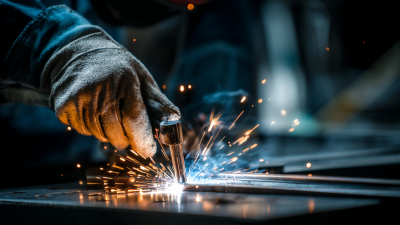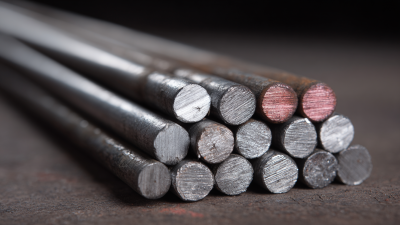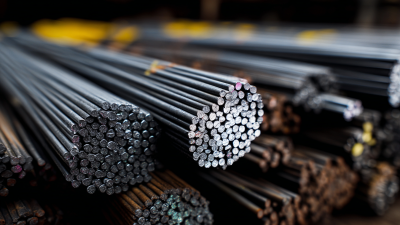How to Choose the Right Flux Cored Wire for Your Welding Projects
Table of Contents
- Factors to Consider When Selecting Flux Cored Wire for Welding
- Understanding the Different Types of Flux Cored Wires Available
- Assessing Welding Thickness and Material Compatibility
- Choosing the Right Shielding Gas for Your Flux Cored Welding
- How to Evaluate the Performance Specifications of Flux Cored Wire
- Tips for Testing and Evaluating Your Chosen Flux Cored Wire in Projects
- A Comprehensive Guide to Stainless Steel Flux Cored Wire E316LT-1: Benefits, Applications, and Selection Tips
- FAQS
- Conclusion
- Related Posts
Picking the right flux cored wire really matters if you want your welding projects to turn out great. I’ve read that, according to the American Welding Society, flux cored arc welding — or FCAW — is becoming super popular lately, especially because it’s so versatile and efficient. It's especially favored in heavy-duty fabrication and industrial work. I mean, with over 22 years of experience, Wenzhou Tianyu Electronic Co., Ltd. has really honed in on making all sorts of welding consumables. They offer top-notch flux cored wires that can handle a bunch of different welding needs. As more folks are looking for welds that are both super strong and resistant to corrosion, it’s pretty clear that understanding these wires isn’t just for the pros anymore. Choosing the right kind of wire can seriously make a difference — it affects how well your welds turn out, their quality, and how quickly you can get things done. When you pick the right wire, it helps make sure your projects not only meet industry standards but also stand up in tough environments.

Factors to Consider When Selecting Flux Cored Wire for Welding
When you're picking out the right flux-cored wire for your welding projects, there are a few important things you should keep in mind to make sure everything goes smoothly and you get the results you want. One of the biggest factors is knowing what kind of job you're doing since different wires are designed for specific environments. For example, ER70T-1 is great if you're welding clean steel in various positions, whereas ER71T-11 offers better penetration, making it more suitable for thicker materials. The American Welding Society notes that choosing the right wire can boost efficiency and even slash your overall project costs by about 25%.
Another thing to think about is the shielding gas you'll need for the particular wire type. Some wires, especially those that are gas-shielded, require a specific gas mix to get the best welds. Using the right gas really helps stabilize the welding arc and cuts down on spatter, resulting in a cleaner, higher-quality weld. On the flip side, choosing the wrong gas or wire combo can seriously compromise the weld's strength—industry reports even suggest that roughly 30% of structural failures are due to poor welding materials.
And finally, don't forget about the wire diameter and thickness—it should match the material you're working with and the welding method you’re using. If the wire’s too thin, it might not hold up against the heat, and if it’s too thick, you could end up with too much heat, which can deform the base metal. A study by the Fabricators & Manufacturers Association found that using the right wire size can boost penetration by up to 40%, which definitely helps speed things up and improves your overall productivity.
Choosing the Right Flux Cored Wire for Welding Projects
This bar chart illustrates different factors to consider when selecting flux cored wire for welding projects, including tensile strength, wire diameter, and usability in different positions.
Understanding the Different Types of Flux Cored Wires Available
When you're picking out the right flux cored wire for your welding projects, it’s pretty important to get a sense of the different types out there and how they can actually affect the quality of your welds. Basically, flux cored wires fall into two main categories: self-shielded and gas-shielded. Self-shielded wires, like the E71T-11, are kind of the go-to if you're working outdoors or in tricky weather since they don't need an external shielding gas. On the flip side, gas-shielded wires, such as E71T-GS, rely on an inert gas and tend to give you cleaner welds with less spatter — perfect for those more detailed, precision tasks.

The The American Welding Society (AWS) even reports that more than 60% of welding jobs nowadays are using flux cored wires, mainly because they’re so versatile and efficient. Plus, studies show that with the right wire, you can actually boost your welding speed by up to 30% compared to traditional methods, which is a huge plus for getting things done faster on fabrication or construction sites. Knowing these differences really helps you pick the best wire for what you’re working on, so you can nail both quality and productivity every time.
Assessing Welding Thickness and Material Compatibility
When you're choosing the right flux cored wire for your welding projects, it’s really important to consider the thickness of the materials and whether they’re compatible. For example, if you're working with different metals like AL6XN super austenitic stainless steel and Inconel 625, the thickness can actually make a big difference in how resistant the joint is to corrosion and how strong it is overall. Recent research suggests that even a relatively small thickness, say around 13 mm, can influence your choice of filler material to make sure everything holds up well under various stresses—especially when it comes to preventing localized attacks or general corrosion.
On top of that, when it comes to structural stuff like orthotropic steel decks, the fatigue life of the welded joints really depends on the residual stresses created during welding. For projects that take a lot of wear and tear, using flux cored wires that are designed for thicker materials can really boost the joint’s ability to resist cracking over time. Some of the latest approaches in assessing fatigue reliability have highlighted how important it is to understand the mechanical behavior and residual stresses from welding. Basically, choosing the right flux cored wire isn’t just about compatibility—it’s about making sure your welds can take the heat and perform reliably, even in tough environments.
Choosing the Right Shielding Gas for Your Flux Cored Welding
Picking the right shielding gas for flux-cored welding is super important if you wanna get high-quality welds. Usually, many folks stick with argon or CO2, but lately, people are realizing that mixing things up a bit can actually improve the weld’s strength and overall finish. For example, using helium as the shielding gas can really change how the weld fuses — it affects how heat spreads and how deep the penetration goes. Welds made with helium tend to come out smoother and often need less cleanup afterward, which is a real bonus for certain jobs.

On top of that, the welding world’s kinda shifting gears. More welders are challenging old habits and looking into new ways of doing things. A recent report even pointed out that blending different gases can really boost welding quality and help cut down on flaws. Plus, paying attention to your gear matters — making sure you’re using a good, air-cooled gun designed specifically for flux-cored welding can make a huge difference. It keeps things durable and efficient, helping you control heat better and, in the end, get those perfect welds. If you stay open to these new practices, you'll probably see your productivity go up and waste go down—always a good thing, right?
How to Evaluate the Performance Specifications of Flux Cored Wire
When you're trying to evaluate the performance specs of flux cored wire, there are a few key things you really want to look at. According to the American Welding Society (AWS), the wire's composition plays a huge role—stuff like the flux core itself, how weldable it is, and how stable the arc runs all make a big difference. For example, wires that contain more alloying elements like manganese and silicon tend to have better mechanical properties and more stable arcs. That usually translates to higher tensile strengths, roughly between 70 to 80 ksi, depending on the specific alloy you choose.
Here's a little tip: always check the AWS specs for whichever application you're working on. It’s a good idea to pick a wire that aligns with industry standards and ticks all your project’s boxes.
Another thing to keep in mind is the gas-shielding capability. Many flux cored wires can be used with or without shielding gases like CO₂ or argon mixtures. From what reports say, using an external shielding gas can really boost the impact strength and toughness of the weld metal, which comes in handy for tougher environments. For instance, dual-shielded wires help reduce porosity and give a cleaner bead appearance — super important when you’re working on structural stuff.
And here’s a practical tip: before jumping into a big project, try doing a bead-on-plate test with the wire you plan to use. It’s a simple way to see how it performs in real-world conditions.
How to Choose the Right Flux Cored Wire for Your Welding Projects
| Wire Type | Diameter (mm) | Filler Material | Flux Type | Applications | Heat Input (kJ/cm) |
|---|---|---|---|---|---|
| E71T-1 | 0.8 | Mild Steel | Self-shielded | Structural Steel Fabrication | 5-10 |
| E71T-11 | 1.0 | Mild Steel | Self-shielded | Sheet Metal Welding | 5-8 |
| E81T1-Ni1 | 1.2 | Nickel Alloy | Dual-shielded | High-temperature Applications | 8-12 |
| E308LT1-1 | 1.0 | Stainless Steel | Gas-shielded | Food Processing Equipment | 5-9 |
| E71T-GS | 0.9 | Mild Steel | Self-shielded | General Purpose Welding | 4-7 |
Tips for Testing and Evaluating Your Chosen Flux Cored Wire in Projects
When you're picking out a flux cored wire for your welding projects, it's super important to really test it out first. Don't just go with the first thing that seems okay—try it out under different conditions to see how it performs. Start by making sure it plays nice with your welding machine and the materials you're working with. Do some test welds on scrap pieces that are the same as what you'll actually be joining. That way, you can get a feel for how the wire behaves, how steady the arc is, and how well it penetrates. Also, pay attention to how effectively it shields the weld from oxidation or contamination—that’s a big deal during the process.
After you've done those initial tests, take a closer look at the welds you've made. Check out how they look—the bead shape, the strength, and how much heat affected zone there is. If you’re into it, you can even do some non-destructive testing, like ultrasonic checks, just to make sure there aren’t any hidden flaws inside. It’s also worth chatting with other welders or checking out technical data sheets to get a sense of how the wire performs in different situations. Putting all this together will help you pick a flux cored wire that really fits your specific needs and ensures consistent, solid results every time.
A Comprehensive Guide to Stainless Steel Flux Cored Wire E316LT-1: Benefits, Applications, and Selection Tips
When it comes to selecting the right welding wire for stainless steel applications, E316LT-1 flux cored wire stands out due to its unique composition and versatile usability. This wire is particularly effective for welding base metals such as AISI Types 301, 302, 304, 305, and 308, making it an ideal choice for various industrial projects. Its formulation includes a maximum carbon content of 0.04%, which significantly enhances resistance to inter-granular corrosion. This characteristic is paramount in environments that expose metal to corrosive elements, ensuring a longer lifespan and reliable performance.
In addition to its corrosion resistance, the E316LT-1 wire minimizes carbide precipitation, a common issue in high-temperature welding that can compromise the integrity of the joint. This property is particularly beneficial for applications in the food processing, pharmaceutical, and chemical industries, where hygiene and durability are critical. By selecting E316LT-1, welders can achieve strong, consistent welds that meet stringent industry standards while maintaining the adaptability necessary for various welding positions. Overall, understanding the benefits and applications of E316LT-1 is essential for making an informed choice when it comes to stainless steel welding projects.
FAQS
: Key factors include the type of application, required shielding gas, and the diameter and thickness of the wire. These considerations ensure optimal performance and project efficiency.
Different wires are formulated for specific environments, such as ER70T-1 for clean steel and ER71T-11 for better penetration in thicker materials.
The right shielding gas can improve arc stability, reduce spatter, and enhance overall weld quality. Improper gas selection can compromise weld integrity, contributing to structural failures.
The diameter should match material thickness and welding techniques. Using the correct wire diameter can improve penetration rates and significantly boost productivity.
Flux cored wires are categorized into self-shielded, which can be used without external gas, and gas-shielded, which require inert gas for superior weld quality.
Flux cored wires can enhance welding speeds by up to 30% and are versatile, making them increasingly popular in welding operations.
The thickness of materials affects corrosion resistance and joint integrity. Choosing the right filler material is essential for performance in high-stress applications.
Assessing material compatibility is crucial, especially with dissimilar metals, to ensure optimal performance and prevent issues like crack propagation in welded joints.
Fatigue reliability is vital for welded joints in high-stress environments. Using wires designed for thicker materials can enhance resistance to crack propagation.
Understanding the different types of flux cored wires and their specific applications allows welders to make informed choices, leading to better quality and efficiency in their projects.
Conclusion
Picking the right flux-cored wire really makes a difference when you're trying to get solid results with your welding projects. There are quite a few things you’ll want to keep in mind to make sure things go smoothly. First off, it helps to understand the different types of flux-cored wires out there—each one is designed for specific applications, so knowing what's available is a good starting point. Then, you'll want to think about the thickness of the material you're welding and compatibility—that way, you can pick a wire that actually works for your job. Oh, and don’t forget about the shielding gas! Choosing the right gas can really improve the appearance of your weld bead and cut down on defects.
Also, it’s important to check out the performance specs of the flux-cored wire. These tell you if the wire is suitable for your particular project. To really be sure, it’s a good idea to do some testing and see how it performs in your setup. With over 22 years of experience, Wenzhou Tianyu Electronic Co., Ltd. specializes in top-quality welding electrodes and consumables, so they’re a dependable partner when it comes to finding the perfect flux-cored wire for your needs.
Related Posts
-

Ultimate Comparison of Welding Rod Sizes: Finding the Perfect Fit for Your Projects
-

How to Choose the Best Aluminum Stick Welding Rod for Your Projects
-

Exceptional Tig Electrodes from Leading Chinese Manufacturers for Global Buyers
-

15 Best Tips for Choosing the Best Flux Core Mig Wire for Your Business
-

Mastering Hard Facing Techniques with the Best Hard Facing Welding Rods for Superior Durability
-

Solutions for Enhancing Welding Quality with 6010 Welding Rod


